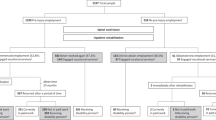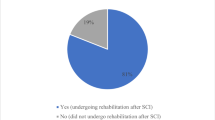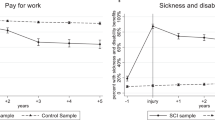Abstract
Study design:
Multicenter, prospective study.
Objectives:
To assess the occurrence and predictors of return to work after traumatic spinal cord injury (SCI).
Setting:
Italian rehabilitation centers.
Methods:
We evaluated patients previously included in the Italian Group for the Epidemiological Study of Spinal Cord Injuries study. A standardised telephone interview was used to collect data after a mean follow-up of 3.8 years. The main outcome measure was employment at the end of follow-up.
Results:
A total of 403 patients, 336 men and 67 women, with a mean age of 41.8±16.3 years, were included in the follow-up. In all, 42.1% of patients were employed at the moment of the interview, though 62% reported a worsening in their employment level. Predictors of employment were education (P<0.0001), bowel continence (P=0.02), independence in mobility (P=0.0004), ability to drive (P<0.0001), participating in the community (P=0.0001) and ability to live alone (P<0.0001) while age (P<0.0001), being married (P<0.0001), tetraplegia (P=0.03), occurrence of recent medical problems (P=0.002), re-hospitalization (P=0.02), presence of architectonic barriers (P=0.009) and having a public welfare subsidy (P<0.0001), predicted unemployment. On the basis of multivariate analysis, younger age, education, absence of tetraplegia, ability to drive, ability to live alone, previous employment were independent predictors of employment after SCI. Employment at follow-up was related to several indicators of quality of life.
Conclusion:
Employment after SCI was rather frequent and was related to several patient characteristics and social factors. Specific interventions on the patient and on the social environment may favor employment after SCI and improve quality of life.
Similar content being viewed by others
Log in or create a free account to read this content
Gain free access to this article, as well as selected content from this journal and more on nature.com
or
References
MacKenzie EJ, Shapiro S, Smith RT, Siegel JH, Moody M, Pitt A . Factors influencing return to work following hospitalization for traumatic injury. Am J Public Health 1987; 77: 329–334.
Noreau L, Dion SA, Vachon J, Gervais M, Laramée MT . Productivity outcomes of individuals with spinal cord. Spinal Cord 1999; 37: 730–736.
Krause JS, Coker JL . Aging after spinal cord injury: a 30-year longitudinal study. J Spinal Cord Med 2006; 29: 371–376.
Schönherr MC, Groothoff JW, Mulder GA, Schoppen T, Eisma WH . Vocational reintegration following spinal cord injury: expectations, partecipation and interventions. Spinal Cord 2004; 42: 177–184.
Priebe MM, Chiodo AE, Scelza WM, Kirshblum SC, Wuermser LA, Ho CH . Spinal cord injury medicine. 6. economic and societal issues in spinal cord injury. Arch Phys Med Rehabil 2007; 88 (3 Suppl 1): S84–S88.
Pflaum C, McCollister G, Strauss DJ, Shavelle RM, DeVivo MJ . Worklife after traumatic spinal cord injury. J Spinal Cord Med 2006; 29: 377–386.
Lidal IB, Hjeltnes N, Røislien J, Stanghelle JK, Biering-Sørensen F . Employment of persons with spinal cord lesions injured more than 20 years ago. Disabil Rehabil 2009; 31: 2174–2184.
Krause JS, Terza JV, Saunders LL, Dismuke CE . Delayed entry into employment after spinal cord injury: factors related to time to first job. Spinal Cord 2010; 48: 487–491.
Anzai K, Young J, McCallum J, Miller B, Jongbloed L . Factors influencing discharge location following high lesion spinal cord injury rehabilitation in British Columbia, Canada. Spinal Cord 2006; 44: 11–18.
Lin MR, Hwang HF, Yu WY, Chen CY . A prospective study of factors influencing return to work after traumatic spinal cord injury in Taiwan. Arch Phys Med Rehabil 2009; 90: 1716–1722.
Pagliacci MC, Celani MG, Spizzichino L, Zampolini M, Aito S, Citterio A et al. on behalf of GISEM Spinal Cord Lesion management in Italy: two years survey. Spinal Cord 2003; 41: 620–628.
Franceschini M, Di Clemente B, Citterio A, Pagliacci MC . Follow-up in persons with traumatic spinal cord injury: questionnaire reliability. Eura Medicophys 2006; 42: 211–218.
DeVivo MJ, Rutt RD, Stover SL, Fine PR . Employment after spinal cord injury. Arch Phys Med Rehabil 1987; 68: 494–498.
Tomassen PCD, Post MWM, van Asbeck FW . Return to work after spinal cord injury. Spinal Cord 2000; 38: 51–55.
Ramakrishnan K, Mazlan M, Julia PE, Abdul Latif L . Return to work after spinal cord injury: factors related to time to first job. Spinal Cord 2011; 49: 1–4.
Donnelly C, McColl MA, Charlifue S, Glass C, O'Brien P, Savic G et al. Utilization, access and satisfaction with primary care among people with spinal cord injuries: a comparison of three countries. Spinal Cord 2007; 45: 25–36.
Ottomanelli L, Lind L . Spinal cord injury:implications for research and vocational services. J Spinal Cord Med 2009; 32: 503–531.
Pillastrini P, Mugnai R, Bonfiglioli R, Curti S, Mattioli S, Maioli MG et al. Evaluation of an occupational therapy program for patients with Spinal Cord Injury. Spinal Cord 2008; 46: 78–81.
Whiteneck G, Meade MA, Dijkers M, Tate DG, Bushnik T, Forchheimer MB . Environmental factors and their role in partecipation and life satisfaction after spinal cord injury. Arch Phys Med Rehabil 2004; 85: 1793–1803.
Anneken V, Hanssen-Doose A, Hirschfeld S, Thietje R . Influence of physical exercise on quality of life in individuals with spinal cord injury. Spinal Cord 2010; 48: 393–399.
Author information
Authors and Affiliations
Consortia
Corresponding author
Ethics declarations
Competing interests
The authors declare no conflict of interest.
Appendix
Appendix
The GISEM group included the following investigators and centers: Ceravolo MG, Clinica di Neuroriabilitazione, Ancona; Nardulli R, Centro Medico Cassano Murge - IRCCS, Cassano Murge; Aito S, Unità Spinale CTO, Firenze; Cellotto N, Centro Riabilitazione ‘Villa Beretta’, Costamasnaga; Zucchi AG, Sezione Mielolesi, Magenta; Manera C, Unità Spinale Unipolare Osp. Niguarda, Milano; Bava A, Divisione Paraplegici CTO, Milano; Ghislandi I, SRRF Ospedale di Bergamo – Sez. Mozzo, Mozzo; Ortolani M, Servizio di Riabilitazione Ortopedica, Padova; Taricco MA, Ospedale Casati, Passirana di Rho; Pistarini C, Centro Medico Montescano, Pavia; Mosetti A, Ospedale Villa Rosa - CRF, Pergine Valsugana; Pagliacci MC, Unità Spinale Unipolare Osp. Silvestrini, Perugia; Gatta G, SRRF Ospedale S. M. delle Croci, Ravenna; Scivoletto G, IRCCS Santa Lucia, Roma; Trigila A, Unità Spinale Unipolare CTO, Roma; Occhi E, Unità Spinale, Sondalo; Loria D, Unità Spinale, Torino; Zampolini M, U.O. di Riabilitazione Intensiva Neuromotoria, Trevi; Di Benedetto P, Centro di Riabilitazione, Trieste; Cordioli Z, Reparto di RRF Ospedale Sacro Cuore - Don Calabria - Negrar, Verona; Leucci M, UORRF Unità Spinale Osp. S. Bartolo, Vicenza; Lotta S, Centro di R.R.F., Villanova d'Arda; Strazzabosco C, Istituto Riabilitazione Neuromotoria, Mezzaselva di Roana.
Rights and permissions
About this article
Cite this article
Franceschini, M., Pagliacci, M., Russo, T. et al. Occurrence and predictors of employment after traumatic spinal cord injury: the GISEM Study. Spinal Cord 50, 238–242 (2012). https://doi.org/10.1038/sc.2011.131
Received:
Revised:
Accepted:
Published:
Issue date:
DOI: https://doi.org/10.1038/sc.2011.131
Keywords
This article is cited by
-
Return to work after traumatic spinal fractures and spinal cord injuries: a retrospective cohort study
Scientific Reports (2023)
-
Spinal cord injury and work challenges: an analysis of paid work status and pathways of return to work in Brazil
Spinal Cord (2021)
-
Promoting factors and barriers to participation in working life for people with spinal cord injury
Journal of Occupational Medicine and Toxicology (2020)
-
Relationships between type of pain and work participation in people with long-standing spinal cord injury: results from a cross-sectional study
Spinal Cord (2018)
-
Return-to-work intentions during spinal cord injury rehabilitation: an audit of employment outcomes
Spinal Cord (2016)



